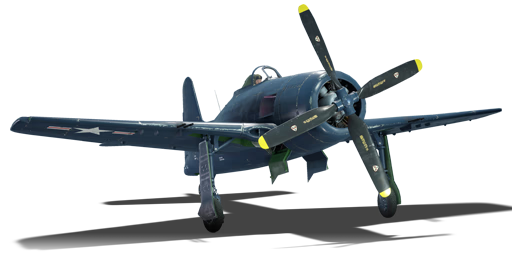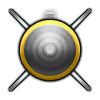



The F8F Bearcat was designed after the Battle of Midway. It was realized that an aircraft's rate of climb was extremely important, so it was decided to use the same Pratt & Whitney R-2800 radial used on the earlier F6F Hellcat, but in a lighter airframe, capable of greater speed and climb rate. This came at the cost of range and armour for the pilot; the aircraft also featured a bubble canopy for all-around visibility. However, the fighter was developed too late for WWII. After the war, the introduction of naval jet aircraft like the F2H Banshee forced its early retirement; however, some of these fighters were used by France in Indochina against Viet Minh troops.
Introduced in Update 1.33, the F8F-1B is truly a worthy aircraft to end the single engine fighter line of the USN branch. Nimble, fast, and with great acceleration, it is sight of fear for the foe's eye. Most of its enemies will be jets and they will shiver as the Bearcat faces them with a 2 km altitude and speed advantage. With WEP running (War Emergency Power), which includes ADI (Water-Methanol Injection) for the big and hungry 2,300 horsepower Pratt & Whitney R-2800 Double Wasp, and modules maximized, the climb rate is well over 35 m/s. However, its main weakness is the Bearcat's very power source: the hot-running R-2800 Double Wasp, which will quickly overheat if left unattended.
flaps
flaps
flaps
brake
| Belt | Belt filling | Armor penetration (mm) at a distance: | |||||
|---|---|---|---|---|---|---|---|
| 10 m | 100 m | 500 m | 1000 m | 1500 m | 2000 m | ||
| HEF-I/AP-T | 36 | 33 | 23 | 15 | 9 | 6 | |
| AP-T/AP-T/HEF-I/HEF-I | 36 | 33 | 23 | 15 | 9 | 6 | |
| HEF-I/HEF-I/HEF-I/AP-T | 36 | 33 | 23 | 15 | 9 | 6 | |
| AP-T/AP-T/AP-T/HEF-I | 36 | 33 | 23 | 15 | 9 | 6 | |
| HEF-I | 5 | 4 | 3 | 2 | 2 | 2 | |
| Name | Weight | Slot | ||||||
|---|---|---|---|---|---|---|---|---|
| 2 × | 125.6 kg |  |  | |||||
| 534.2 kg |  |  | ||||||
| 242.6 kg |  |  |  | |||||
| 500.8 kg |  |  |  | |||||
| 2 × | 233.3 kg |  |  | |||||












Flight performance | |
|---|---|
Survivability |
|---|
Weaponry | |
|---|---|